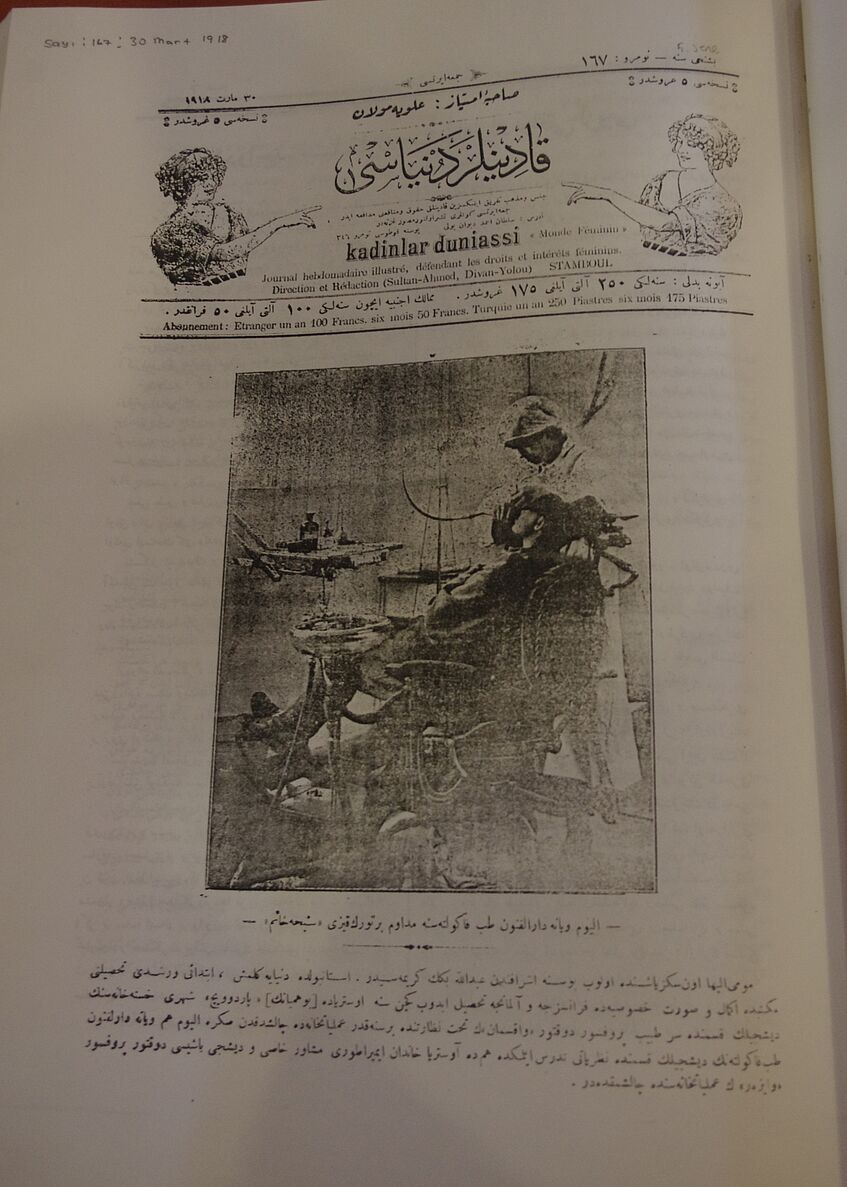Interview with Enise Şeyda Kapusuz (Andreas Tietze Fellow 2024)

El yevm Viyana Dar’ülfununun’da Tıp Fakültesine Müdavim bir Türk kızı ‘Sabiha Hanım’(Today, a Turkish girl, 'Sabiha Hanım,' has become a student at the Medical Faculty of the University of Vienna (Darülfünun).” Kadınlar Dünyası 167 (30 March 1918): Cover
Interview with Enise Şeyda Kapusuz (Andreas Tietze Fellow 2024)
Would you briefly introduce yourself?
I am a Ph.D. candidate in the History Department at the European University Institute. In addition to that I am a teaching fellow at the ELTE University as a part of CEU Global Teaching Fellowship Program. My Ph.D. thesis focuses on the modernization experience of Muslim women in late Ottoman Istanbul during the last ten years of the Empire. My research is centered on the role of photography as a catalyst in/for Muslim women’s modernization. I use the concepts of the New Woman, self-fashioning, and self-civilizing as my main analytical concepts.
What are you currently working on?
I am working on my project “A Long History of Migration: Ottoman Muslim Women’s Activities in Vienna during and after WWI (1914-1919)” which is a part of the Andreas Tietze Fellowship Program at the University of Vienna and is funded by the MA7- the Cultural Department of the City of Vienna. My current project aims to discover the hidden histories of Muslim women who migrated/traveled from Istanbul to Vienna during and after WWI. The main research questions are why Vienna was a popular destination for Ottoman Muslim women to migrate/travel and how they became a part of everyday life in Vienna during and after WWI. The method of this research is based on deep archival research and analysis of multiple forms of primary sources. The biggest part of the research will be held in several archives in Vienna such as the Vienna City and State Archives, the Vienna Library and the Austrian National Library, and the Presidential Ottoman Archive in Istanbul. The project aims to deepen our knowledge of the history of WWI, the history of gender and migration, and the history of contemporary Viennese culture.
Why did you apply to the Andreas Tietze Memorial Fellowship?
I moved to Vienna as a part of my MA studies in the MATILDA Program- European Gender History organized by Central European University and the University of Vienna in 2016. Since I arrived in Vienna, I have been impressed by the shared history between the two cities: Istanbul, where I originated from, and Vienna as two capitals of former empires connected through the Balkans, and the cultural exchange between different communities from these cities through migration. Therefore, I would like to research the women from Istanbul who migrated to Vienna as I did several years ago. The Andreas Tietze Memorial Fellowship is a wonderful opportunity for me to realize my project. Thanks to the Fellowship Program, I am better connected with the local academic community in Vienna. I am using the facilities of the University of Vienna, such as the library of the Department of the Oriental Studies Institute. Moreover, the highly active academic life in the Department provides me the opportunity to be updated about the latest research in the field of Ottoman-Turkish Studies.
How did the fellowship contribute to your research?
I have to admit that I am at a very early stage of my research project. However, I can say that the fellowship has already contributed to my research in several ways. Since I was selected as a fellow, I have been warmly welcomed by the members of the Department. I had the chance to attend the Comparative Habsburg-Ottoman Paleography Summer School organized by the Turkology Department at the University of Vienna and the Institute for Habsburg and Balkan Studies (IHB) at the Austrian Academy of Sciences during the summer of 2024. The Summer School organized by the Department introduced me to the archives where the main primary source materials of my research are stored. I very much appreciate the academic cooperation between the academic institutions and the colleagues at the Department which supported me in navigating the local institutional structures.
Do you want to publish or present your research to the academic community? How will it go further?
Yes! First, I would like to have a public lecture hosted by the Oriental Studies Institute in Vienna. In addition to that I would like to publish at least one academic article as an outcome of my research. I believe that the project has a huge innovation potential to create a public history portal. The visual material together with the other various primary materials can be used to create an exhibition for the Viennese public in the future. The exhibition form can provide citizens of Vienna to witness the history of the city in a visual, spatial, and material form. Therefore, I would like to continue to cooperate with the City of Vienna and the University of Vienna to make the outcomes of my project accessible to a wider audience.
